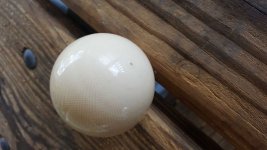Non-destructive test
Hi again,
The best non-destructive test technique is x-ray fluorescence in which the constituent elements are excited by an x-ray beam. In a series of electron orbital events, each element will re-radiate characteristic x-rays of unique and known energy. Detecting these x-rays identifies the elements present in the specimen. For ivory there will be chiefly calcium and phosphorous characteristic x-rays given off. Ivory, like all mammal bone and teeth, is composed essentially of the mineral hydroxyapatite - Ca10(PO4)6(OH)2. A minor amount of collagen and related organic compounds hold the microscopic apatite "bricks" together. Thus the expected Ca and P signals. Where do you get an XRF instrument? They are common in geology, environmental, and materials science labs. I've got 3 in my lab, including a hand-held unit the size of a cordless drill. Call your local university and see whether anyone could do the analysis - it would take about 10 seconds of exposure and less than a minute for the whole deal.
The x-rays do not alter the ivory; perhaps if you exposed it for a day there could be some color change.
Take care,
Nick
Hi again,
The best non-destructive test technique is x-ray fluorescence in which the constituent elements are excited by an x-ray beam. In a series of electron orbital events, each element will re-radiate characteristic x-rays of unique and known energy. Detecting these x-rays identifies the elements present in the specimen. For ivory there will be chiefly calcium and phosphorous characteristic x-rays given off. Ivory, like all mammal bone and teeth, is composed essentially of the mineral hydroxyapatite - Ca10(PO4)6(OH)2. A minor amount of collagen and related organic compounds hold the microscopic apatite "bricks" together. Thus the expected Ca and P signals. Where do you get an XRF instrument? They are common in geology, environmental, and materials science labs. I've got 3 in my lab, including a hand-held unit the size of a cordless drill. Call your local university and see whether anyone could do the analysis - it would take about 10 seconds of exposure and less than a minute for the whole deal.
The x-rays do not alter the ivory; perhaps if you exposed it for a day there could be some color change.
Take care,
Nick
 .
. 

